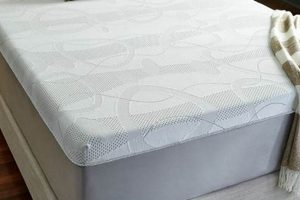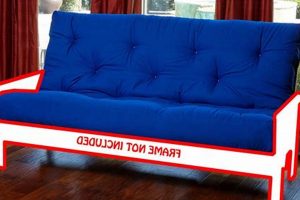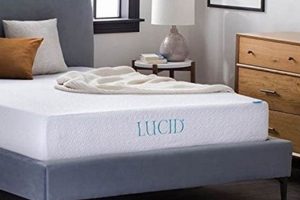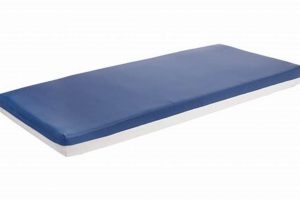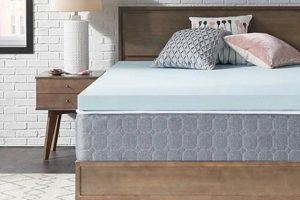Memory foam overlays, designed to rest atop a mattress, introduce a conforming layer that can influence the wear and tear experienced by the underlying surface. These additions act as a buffer between the sleeper and the mattress, potentially mitigating direct pressure and friction. For instance, spills and stains are more likely to be absorbed by the topper rather than penetrating into the mattress itself.
The value of these overlays lies in their ability to extend the lifespan of a mattress and preserve its condition. They achieve this by absorbing much of the direct impact from body weight and movement during sleep. Furthermore, they can safeguard against common issues such as indentations and sagging that can occur over time. Historically, simpler mattress covers were used primarily for hygiene; however, modern materials like memory foam offer enhanced protective capabilities.
This article will delve into the specific mechanisms by which memory foam overlays contribute to mattress preservation, examining factors like material density, thickness, and their effectiveness against various forms of wear and tear. It will also consider alternative protective measures and their relative merits.
Protecting Your Mattress with Memory Foam Overlays
The following tips offer insights into how memory foam overlays can contribute to mattress preservation, focusing on practical aspects and long-term benefits.
Tip 1: Select Appropriate Density: Higher density memory foam offers superior support and resistance to compression, resulting in greater protection against indentations. Choose a density that aligns with the user’s body weight and sleeping habits for optimal mattress preservation.
Tip 2: Consider Topper Thickness: A thicker memory foam overlay provides a more substantial barrier against wear and tear. While a thinner topper offers basic protection, a thicker one can absorb more impact and extend the mattress’s lifespan more effectively.
Tip 3: Utilize a Waterproof Protector: Pairing the memory foam overlay with a waterproof mattress protector adds an extra layer of defense against spills and stains. This is particularly important for households with children or pets.
Tip 4: Regularly Rotate the Topper: Periodic rotation of the memory foam overlay can help distribute wear more evenly, preventing localized compression and extending its protective lifespan. Consider rotating it every few months.
Tip 5: Ensure Proper Support Beneath: A memory foam overlay’s effectiveness is contingent on the condition of the mattress beneath. A sagging or uneven mattress will undermine the topper’s ability to provide uniform support and protection.
Tip 6: Clean According to Manufacturer Instructions: Following the manufacturers guidelines for cleaning the memory foam overlay maintains its integrity and protects the underlying mattress from potential damage caused by harsh cleaning agents.
By implementing these strategies, individuals can maximize the protective benefits of memory foam overlays, safeguarding their mattresses against a range of potential damage factors. This proactive approach offers a cost-effective method for prolonging the life and comfort of a valuable sleep surface.
The final section will explore the longevity of memory foam toppers and compare them with others available on the market.
1. Pressure Redistribution
Pressure redistribution, a core characteristic of memory foam, is intrinsically linked to its capacity to safeguard a mattress. When a body rests on a conventional mattress, weight concentrates at pressure points like the hips and shoulders. This focused pressure can accelerate wear in these areas, leading to sagging and diminished support over time. Memory foam overlays, however, conform to the body’s contours, distributing weight across a wider surface area. This reduces the intensity of pressure at any single point, thereby mitigating the risk of localized damage to the underlying mattress.
For instance, consider a scenario where an individual consistently sleeps on their side. Without a memory foam overlay, the mattress beneath their hip would bear the brunt of their weight, potentially causing a permanent indentation. A memory foam topper, by conforming to the body’s shape, spreads this weight more evenly, minimizing stress on that specific area of the mattress. This is crucial for preventing premature wear and tear, especially in mattresses with less robust construction. The effectiveness of this redistribution is directly proportional to the topper’s density and thickness; higher density foam will offer better support and more efficient pressure dispersion.
In conclusion, the ability of memory foam overlays to redistribute pressure is a significant factor in their protective function. By minimizing localized stress and distributing weight more uniformly, these toppers contribute to the longevity and sustained integrity of the mattress. While other protective measures exist, pressure redistribution remains a key mechanism by which memory foam effectively mitigates wear and prolongs the lifespan of the sleep surface. This effect is contingent on the quality and characteristics of the memory foam material itself.
2. Spill Absorption
Spill absorption is a critical factor influencing the degree to which memory foam overlays offer protection to a mattress. While memory foam is not inherently waterproof, its capacity to absorb liquids can have significant implications for the underlying mattress. The interplay between a topper’s absorption properties and a mattress’s vulnerability to liquid damage directly impacts long-term preservation.
- Initial Liquid Retention
The initial capacity of a memory foam overlay to retain spilled liquids is pivotal. Upon initial contact, the foam absorbs a portion of the spill, preventing immediate penetration to the mattress below. For instance, a small spill of water may be contained within the topper’s upper layers, allowing time for cleanup before it reaches the mattress. However, this retention also means the topper itself becomes vulnerable to staining and mold growth if not addressed promptly.
- Depth of Penetration
The extent to which a spill penetrates the memory foam layer directly affects the level of protection offered. Thicker, denser overlays tend to impede deeper penetration compared to thinner, less dense options. A spill on a thin topper might quickly seep through to the mattress, while a thicker topper may delay or even prevent this. The composition of the liquid also plays a role; viscous liquids will penetrate slower than less dense alternatives.
- Subsequent Mold and Mildew Growth
Retained moisture within a memory foam overlay ca
n foster the growth of mold and mildew, posing both a hygienic concern and a threat to the mattress. Even if the initial spill does not reach the mattress, prolonged moisture retention in the topper can lead to mold spores migrating downwards, potentially infesting the mattress over time. Regular cleaning and thorough drying are crucial to mitigate this risk. - Importance of Waterproof Barriers
The effectiveness of spill absorption as a protective measure is significantly enhanced when the memory foam overlay is used in conjunction with a waterproof mattress protector. The protector acts as an impermeable barrier, preventing liquids from reaching either the topper or the mattress. This combination provides the most robust defense against spills, mitigating the risks associated with both liquid penetration and subsequent microbial growth.
In summary, while spill absorption is a characteristic of memory foam toppers, it does not inherently guarantee mattress protection. The depth of penetration, potential for mold growth, and the presence of a waterproof barrier all contribute to the overall effectiveness of the topper in safeguarding against liquid damage. Therefore, relying solely on the absorbent properties of memory foam is insufficient; a comprehensive approach, including waterproof protection and regular maintenance, is essential for preserving the mattress.
3. Friction Reduction
Friction reduction, as it pertains to mattress protection through the utilization of memory foam overlays, addresses a significant mechanism by which wear and tear are mitigated. The degree to which a topper diminishes frictional forces directly impacts the longevity and structural integrity of the underlying mattress.
- Surface Conformity and Shear Stress
Memory foam overlays, by conforming to the body’s shape, distribute weight more evenly and reduce localized pressure points. This conformity minimizes the relative movement between the sleeper and the mattress surface. In the absence of such a topper, shifting during sleep can cause the sleeper’s body to rub directly against the mattress, generating shear stress that degrades the fabric and internal components over time. For example, the repeated twisting motion of a sleeper can abrade the mattress ticking, eventually leading to tears or thinning of the material.
- Mitigation of Internal Abrasion
Internal components of a mattress, such as coils and padding layers, are also subject to frictional forces. When a sleeper moves, these components rub against each other, leading to breakdown and diminished support. Memory foam overlays act as a dampening layer, absorbing much of the energy from these movements and reducing the intensity of the internal abrasion. The increased stability provided by the topper limits the range of motion within the mattress, thus preserving its structural integrity. A mattress without such protection experiences more direct force transmission, accelerating the wear on its internal elements.
- Prevention of Ticking Degradation
The mattress ticking, the outermost fabric layer, is particularly susceptible to friction-induced damage. Direct contact with bedding, clothing, and skin can cause the ticking to wear thin, pill, or tear. A memory foam overlay introduces a buffer layer, minimizing direct contact and reducing the abrasive forces acting on the ticking. This is particularly important for mattresses with delicate or loosely woven ticking, where even minor friction can lead to significant damage. Preserving the ticking’s integrity is essential, as it protects the underlying components from dust, allergens, and further wear.
- Reduction of Bedding Wear
The presence of a memory foam topper also impacts the bedding used. By providing a smoother, more uniform surface, the topper reduces friction between the sheets and the mattress. This minimizes wear and tear on the bedding itself, extending its lifespan. A rough or uneven mattress surface, in contrast, can cause sheets to pill, tear, or wear thin more quickly due to increased friction. This effect, while indirect, contributes to the overall cost-effectiveness of using a memory foam overlay as a protective measure for the entire sleep system.
The cumulative effect of these friction-reducing properties is a substantial contribution to the preservation of the mattress. By minimizing shear stress, internal abrasion, ticking degradation, and bedding wear, memory foam overlays serve as a proactive defense against the forces that degrade a mattress over time. The degree of protection offered is contingent on the topper’s quality, density, and the specific characteristics of the mattress itself, but the underlying principle of friction reduction remains a key factor in the efficacy of these overlays. Other methods such as mattress encasements and regular cleaning also play a role, but the unique ability of memory foam to conform and dampen movement provides a distinct advantage in mitigating frictional wear.
4. Wear Mitigation
Wear mitigation is a central component of how memory foam overlays contribute to mattress protection. Mattresses are subject to various forms of wear stemming from pressure, friction, and environmental factors. The extent to which a memory foam overlay can lessen these effects determines its effectiveness in prolonging the mattress’s lifespan. The primary function of these overlays, in relation to wear, involves absorbing and distributing forces that would otherwise concentrate on the mattress’s surface and internal structure. For instance, consistent sleeping in the same position can lead to localized compression and sagging in a mattress. A memory foam overlay, by conforming to the body, distributes the sleeper’s weight more evenly, minimizing this concentrated pressure. Similarly, movements during sleep generate friction between the sleeper and the mattress; the overlay acts as a buffer, reducing direct abrasion and wear on the mattress ticking.
The density and thickness of the memory foam overlay directly correlate with its ability to mitigate wear. A high-density topper provides greater resistance to compression and deformation, maintaining its support and protective qualities over time. A thicker topper offers a more substantial barrier against pressure and friction, further reducing the strain on the mattress. However, wear mitigation is not solely dependent on the topper itself. Proper support beneath the mattress is also crucial. If the mattress is placed on a sagging or uneven foundation, the topper’s ability to distribute weight effectively is compromised. Furthermore, regular maintenance, such as rotating the topper and using a mattress protector, is essential for maximizing its protective capabilities and preventing the buildup of moisture and contaminants that can accelerate wear.
In summary, wear mitigation is a critical function of memory foam overlays in preserving mattresses. By distributing pressure, reducing friction, and providing a protective barrier, these overlays help to extend the lifespan and maintain the comfort and support of the underlying mattress. The effectiveness of wear mitigation depends on factors such as topper density, thickness, proper support, and regular maintenance. While memory foam overlays offer a valuable means of minimizing wear, they are not a substitute for addressing underlying issues with mattress supp
ort or neglecting routine care. The understanding and implementation of these factors are essential for maximizing the protective benefits of memory foam overlays.
5. Contamination Barrier
A mattress is susceptible to various contaminants, including dust mites, allergens, body fluids, and spills. These substances can penetrate the mattress fibers, leading to hygiene issues, odors, and degradation of the mattress materials. Memory foam overlays, when properly utilized, serve as a partial barrier against these contaminants, thus contributing to the preservation of the underlying mattress. The effectiveness as a contamination barrier depends significantly on the overlay’s density, thickness, and whether it is used in conjunction with a waterproof mattress protector.
The most immediate effect is the reduction of direct contact between potential contaminants and the mattress surface. For instance, a spill of liquid, instead of immediately soaking into the mattress, may be largely absorbed by the memory foam overlay, providing an opportunity for cleaning before it reaches the underlying material. Similarly, the overlay can trap dust mites and allergens, preventing them from embedding deeply within the mattress. Regular cleaning of the overlay is then crucial to remove these trapped contaminants. However, memory foam is porous and not inherently impermeable; therefore, it cannot provide complete protection. A waterproof mattress protector is essential to prevent liquids from seeping through the overlay and into the mattress. Without such a barrier, the overlay itself can become a breeding ground for mold and bacteria, leading to further contamination.
In summary, memory foam overlays offer a degree of protection against contamination, but they are not a standalone solution. Their effectiveness hinges on factors such as density, thickness, and, critically, the addition of a waterproof mattress protector. Regular cleaning of the overlay is also necessary. The primary benefit is the reduction of direct contact between contaminants and the mattress, providing an opportunity for cleaning and preventing deep penetration. However, a comprehensive approach that includes a waterproof barrier is essential for maximizing the protective capabilities of memory foam overlays in the context of mattress preservation.
6. Impact Dampening
Impact dampening, the ability to absorb and dissipate force from sudden impacts or movements, plays a vital role in how memory foam overlays contribute to safeguarding a mattress. Mattresses are continually subjected to impacts from activities such as sitting, lying down, and tossing during sleep. These repeated impacts, even if seemingly minor, contribute to gradual wear and tear. Memory foam’s inherent viscoelastic properties enable it to absorb a significant portion of this kinetic energy, thereby reducing the stress transmitted to the underlying mattress. For example, consider an individual who frequently sits on the edge of their bed. Without a memory foam overlay, the concentrated impact of their weight would directly compress the mattress’s edge, leading to sagging over time. However, a memory foam topper disperses this force, cushioning the impact and minimizing the localized compression on the mattress core.
The effectiveness of impact dampening is dependent on the density and thickness of the memory foam. Higher-density foam provides greater resistance to compression and offers more effective absorption of force. A thicker topper, similarly, provides a more substantial buffer layer, further reducing the impact transmitted to the mattress. Furthermore, the design of the mattress itself influences the benefit of impact dampening. Mattresses with less robust internal construction are more susceptible to damage from repeated impacts, making the protective qualities of a memory foam overlay particularly valuable. In addition to material properties, proper support beneath the mattress is essential. A sagging or uneven foundation compromises the topper’s ability to effectively dampen impacts, as the uneven surface concentrates stress on certain areas. Real-world applications include preventing coil breakdown in innerspring mattresses and minimizing foam compression in all-foam mattresses.
In summary, impact dampening is a key mechanism by which memory foam overlays protect mattresses from wear and tear caused by sudden movements and concentrated pressure. The extent of this protection depends on the topper’s density, thickness, the mattress’s internal construction, and the quality of its foundation. Recognizing the practical significance of impact dampening provides a valuable perspective on the long-term benefits of using memory foam overlays as a means of extending the lifespan and maintaining the integrity of a sleep surface. The inclusion of a topper offers a tangible benefit, working to lessen the damage caused by everyday use. Other methods like mattress rotation also help.
7. Longevity Extension
The connection between “Longevity Extension” and whether memory foam overlays safeguard a mattress is fundamentally a cause-and-effect relationship. The extent to which a memory foam overlay effectively protects a mattress directly influences its lifespan. The primary goal in employing protective measures, such as these overlays, is to prolong the period of usable comfort and support derived from the mattress. Therefore, “Longevity Extension” serves as a key metric to assess the practical value of using memory foam toppers. For example, consider a high-quality innerspring mattress that might typically last for seven years before significant sagging or wear becomes evident. By adding a memory foam overlay, one might reasonably expect to extend that usable lifespan to nine or ten years, demonstrating a tangible benefit in longevity. The degree of extension is, of course, contingent on the quality of the overlay, the sleeping habits of the user, and the initial condition of the mattress.
Practical applications of understanding this connection extend to informed consumer choices. When selecting a memory foam overlay, considerations should include not only comfort preferences but also the density and thickness of the foam, both of which are directly correlated with its protective capabilities and, therefore, its potential to extend the mattress’s life. Furthermore, integrating this knowledge into routine mattress care practices is crucial. This involves regularly rotating the topper to distribute wear evenly, using a mattress protector to prevent spills and stains from compromising the foam, and ensuring the mattress foundation provides adequate support. Without these complementary measures, the longevity extension provided by the overlay may be significantly diminished. The longevity extension has a financial benefit, avoiding a new mattress investment and environmental because the material is reused longer.
In conclusion, the connection between “Longevity Extension” and the protective properties of memory foam toppers is crucial for assessing their real-world value. This understanding allows for more informed purchasing decisions and reinforces the importance of proper maintenance to maximize the benefits of using these overlays. Challenges remain in accurately quantifying the preci
se degree of longevity extension in diverse use cases, but the underlying principle remains: effective mattress protection translates directly into a longer usable lifespan and a reduced need for premature replacement, with a financial gain. Memory foam toppers can offer protection if quality and use is correct.
Frequently Asked Questions
The following addresses common inquiries and concerns regarding the role of memory foam overlays in safeguarding mattresses.
Question 1: Does a memory foam overlay completely prevent mattress damage?
No, a memory foam overlay does not offer absolute protection. It mitigates certain types of wear and tear, such as pressure points and surface contamination, but it is not impervious to all forms of damage.
Question 2: How does the density of the memory foam affect its protective capabilities?
Higher-density memory foam generally provides superior protection due to its increased resistance to compression and deformation. This translates to better weight distribution and longer-lasting support.
Question 3: Is a waterproof mattress protector still necessary when using a memory foam topper?
Yes, a waterproof mattress protector is highly recommended. Memory foam is absorbent and can retain liquids, leading to potential mold growth or damage to the underlying mattress. A protector provides an essential barrier.
Question 4: How often should a memory foam overlay be cleaned?
Cleaning frequency depends on usage and potential exposure to contaminants. However, a general guideline is to clean the overlay every few months, following the manufacturer’s instructions. Spot cleaning is advisable for spills.
Question 5: Can a memory foam topper revive a sagging mattress?
A memory foam topper can improve comfort and provide some support to a sagging mattress, but it cannot fully restore its original condition. It is a temporary solution, not a permanent fix for significant sagging.
Question 6: Are all memory foam toppers equally effective at protecting a mattress?
No, the effectiveness varies based on factors such as foam density, thickness, quality of materials, and proper usage. Choosing a higher-quality topper and maintaining it properly will maximize its protective benefits.
The consistent takeaway is that memory foam toppers provide a defense against specific forms of damage, they are most beneficial when paired with regular cleaning, maintenance and appropriate accessories.
The final section explores the lifespan and replacement considerations for memory foam toppers themselves.
Conclusion
This exploration of whether memory foam toppers protect the mattress demonstrates a multifaceted benefit. Memory foam overlays offer a degree of protection against specific sources of damage, including pressure concentrations, surface contamination, and frictional wear. However, effectiveness depends critically on material density, topper thickness, and the consistent use of a waterproof mattress protector. The ability of these overlays to extend a mattress’s lifespan should not be overstated, and they do not constitute a substitute for addressing underlying structural issues.
While memory foam overlays are valuable, informed purchasing decisions and regular maintenance are essential to achieve optimal mattress preservation. Consumers are encouraged to carefully evaluate product specifications and adhere to recommended care practices, thereby maximizing the investment in both the overlay and the mattress itself. The continuous study of materials and design innovations may further enhance future protective capabilities, warranting ongoing awareness and assessment.


